Phasmahyla jandaia is a species of frog in the subfamily Phyllomedusinae. It is endemic to Brazil, where it has only been observed more than 1000 meters above sea level.
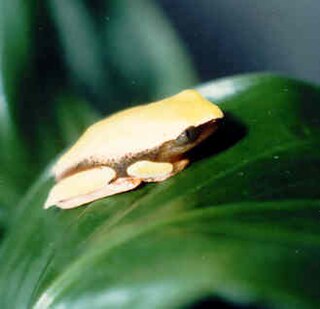
Phrynomedusa marginata, the bicolored leaf frog, is a species of frog in the subfamily Phyllomedusinae. It is endemic to Brazil. People have seen it between 600 and 800 meters above sea level.

Phyllodytes edelmoi is a species of frog in the family Hylidae endemic to Brazil. It has been observed as high as 650 meters above sea level.
The Maracas heart-tongued frog is a species of frog in the family Hylidae endemic to Brazil. Its natural habitats are subtropical or tropical dry forests, dry savanna, and moist savanna. People have seen this frog between 900 and 1350 meters above sea level.
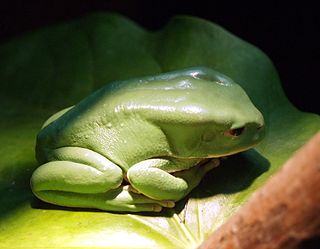
Phyllomedusa boliviana is a species of frog in the subfamily Phyllomedusinae. It is found in Argentina, Bolivia, and Brazil. It has been observed between 200 and 1800 meters above sea level.

Phyllomedusa camba or the black-eyed monkey frog is a species of frog in the subfamily Phyllomedusinae. It is found in Bolivia, Brazil, and Peru. It has been observed between 280 and 1000 meters above sea level.

Phyllomedusa distincta is a species of frog in the subfamily Phyllomedusinae, endemic to Brazil. It has been observed as high as 1000 meters above sea level.
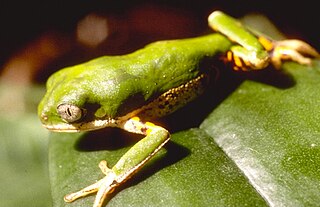
Pithecopus hypochondrialis, the northern orange-legged leaf frog or tiger-legged monkey frog, is a species of frog in the subfamily Phyllomedusinae found in South America. Its natural habitats are subtropical or tropical dry forests, subtropical or tropical moist lowland forests, subtropical or tropical moist shrubland, subtropical or tropical seasonally wet or flooded lowland grassland, intermittent freshwater marshes, pastureland, plantations, rural gardens, urban areas, and heavily degraded former forests. This frog has also been observed in cities. It has been observed as high as 1500 meters above sea level.
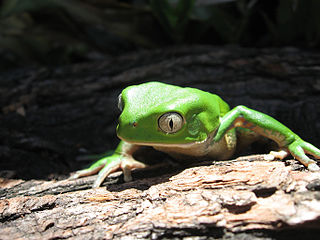
Phyllomedusa iheringii is a species of frog in the subfamily Phyllomedusinae. It is found in southernmost Brazil and Uruguay. The specific name iheringii honors Hermann von Ihering, a German-Brazilian zoologist. However, common name southern walking leaf frog has been proposed for it.
Pithecopus megacephalus, also known as the large-headed leaf frog, is a species of frog in the subfamily Phyllomedusinae. It is endemic to Brazil and is only known from a few peaks in the Espinhaço Mountains in the state of Minas Gerais, where it has been observed 800 meters above sea level.
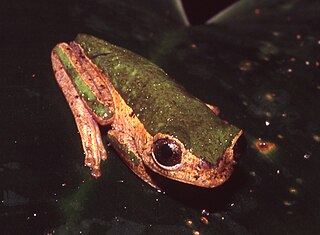
Pithecopus palliatus is a species of frog in the subfamily Phyllomedusinae. It is found in Bolivia, Brazil, Ecuador, Peru, and possibly Colombia. Its natural habitats are subtropical or tropical moist lowland forests and intermittent freshwater marshes. It is threatened by habitat loss. It has been observed between 100 and 400 meters above sea level.
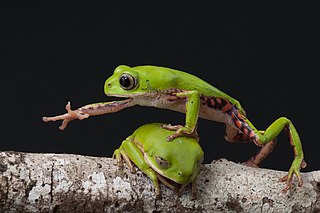
Pithecopus rohdei, also known as Rohde's leaf frog, Rohde's frog, and Mertens' leaf frog, is a species of frog in the subfamily Phyllomedusinae. The species was previously placed in the genus Phyllomedusa. The species is endemic to southeastern Brazil and occurs at elevations up to 1000 meters above sea level.

Phyllomedusa tarsius, the brownbelly leaf frog or tarsier leaf frog, is a species of frog in the subfamily Phyllomedusinae. It is found in Brazil, Colombia, Ecuador, Peru, and Venezuela, and possibly Bolivia and Guyana. This frog has been observed as high as 800 meters above sea level.

Phyllomedusa tetraploidea is a species of frog in the subfamily Phyllomedusinae. It is found in northern Argentina, extreme southeastern Paraguay, and southern Brazil. It occurs in rainforest on herbaceous vegetation near swamps at elevations of 400–1,000 m (1,300–3,300 ft) above sea level. It also occurs in secondary forest and pastures. The eggs are deposited in leaf nests above the water in permanent forest pools; the tadpoles develop in the pools. It is a common species in Brazil and Argentina. Habitat loss caused by agricultural activities is a threat to it. It is present in several protected areas.
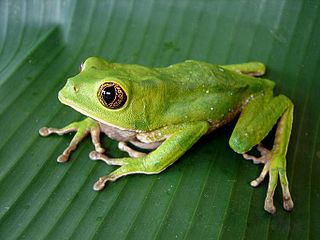
Phyllomedusa venusta is a species of frog in the subfamily Phyllomedusinae, found in Colombia and Panama. Scientists have seen it between 800 and 1400 meters above sea level.
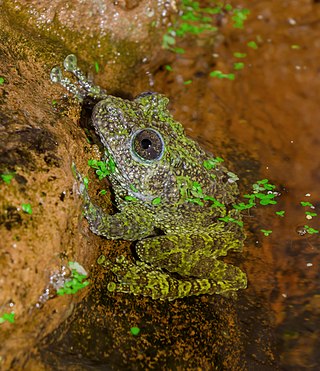
Theloderma corticale is a species of frog in the family Rhacophoridae. It is found in northern Vietnam, south–central Laos, and southern China.

Phasmahyla spectabilis is a species of frog in the subfamily Phyllomedusinae. It is endemic to Brazil and known from the north-eastern Minas Gerais and adjacent southern Bahia. It occurs in fragments of Atlantic Forest at elevations of about 800 m (2,600 ft) above sea level.People have seen it as high as 850 meters above sea level.

Pithecopus araguaius is a species of frog in the family Hylidae, endemic to Brazil. It has been observed in Mato Grasso. This frog has been observed 418 meters above sea level.

Pithecopus rusticus is a species of frog in the family Hylidae, endemic to Brazil. This frog has been observed 1330 meters above sea level.
Phyllomedusa neildi is a species of frog in the family Hylidae endemic to Venezuela. Scientists know this frog solely from its type locality: Sierra de San Luís. This frog has been observed between 550 and 1150 meters above sea level.
















